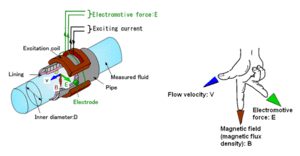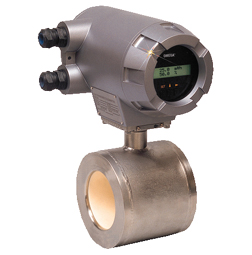Difference between revisions of "Magnetic Flow Meters"
(Created page with "Category:Meters, Gauges{{Knoppen}} <noinclude><!------------------------------------------------ * READ THIS FIRST * Only edit this page if you can improve the content. ...") |
|||
| Line 7: | Line 7: | ||
* Please start editing this page after the /noinclude | * Please start editing this page after the /noinclude | ||
* -------------------------------------------------></noinclude> | * -------------------------------------------------></noinclude> | ||
[[File:Magnetic Flow Meters.gif|thumb|right|Magnetic Flow Meters]] | |||
[[File:Magnetic Flow Meters1.jpg|thumb|right|Magnetic Flow Meters]] | |||
'''Magnetic Flow Meter''' is the third most common flow meter behind differential pressure and positive displacement [[Flow Meters]],also technically an electromagnetic flow meter or more commonly just called a mag meter. A magnetic field is applied to the metering tube, which results in a potential difference proportional to the flow velocity perpendicular to the flux lines. The physical principle at work is electromagnetic induction. The magnetic flow meter requires a conducting fluid, for example, water that contains ions, and an electrical insulating pipe surface, for example, a rubber-lined steel tube. | |||
Usually electrochemical and other effects at the electrodes make the potential difference drift up and down, making it hard to determine the fluid flow induced potential difference. To mitigate this, the magnetic field is constantly reversed, cancelling out the static potential difference. This however impedes the use of permanent magnets for magnetic flowmeters. | |||
The magnetic flow meter requires a conducting fluid and a nonconducting pipe liner. The electrodes must not corrode in contact with the process fluid; some magnetic flowmeters have auxiliary transducers installed to clean the electrodes in place. The applied magnetic field is pulsed, which allows the flow meter to cancel out the effect of stray voltage in the piping system. | |||
Latest revision as of 00:42, 28 December 2012
Magnetic Flow Meter is the third most common flow meter behind differential pressure and positive displacement Flow Meters,also technically an electromagnetic flow meter or more commonly just called a mag meter. A magnetic field is applied to the metering tube, which results in a potential difference proportional to the flow velocity perpendicular to the flux lines. The physical principle at work is electromagnetic induction. The magnetic flow meter requires a conducting fluid, for example, water that contains ions, and an electrical insulating pipe surface, for example, a rubber-lined steel tube.
Usually electrochemical and other effects at the electrodes make the potential difference drift up and down, making it hard to determine the fluid flow induced potential difference. To mitigate this, the magnetic field is constantly reversed, cancelling out the static potential difference. This however impedes the use of permanent magnets for magnetic flowmeters.
The magnetic flow meter requires a conducting fluid and a nonconducting pipe liner. The electrodes must not corrode in contact with the process fluid; some magnetic flowmeters have auxiliary transducers installed to clean the electrodes in place. The applied magnetic field is pulsed, which allows the flow meter to cancel out the effect of stray voltage in the piping system.

